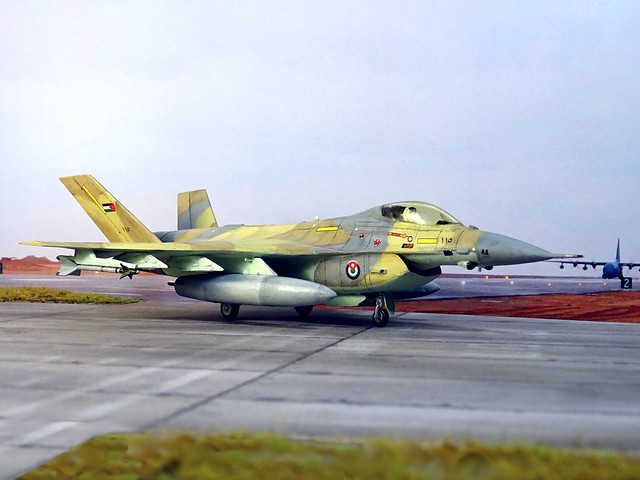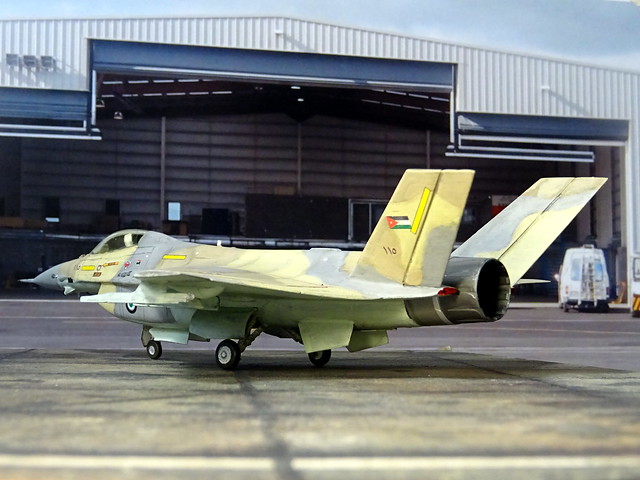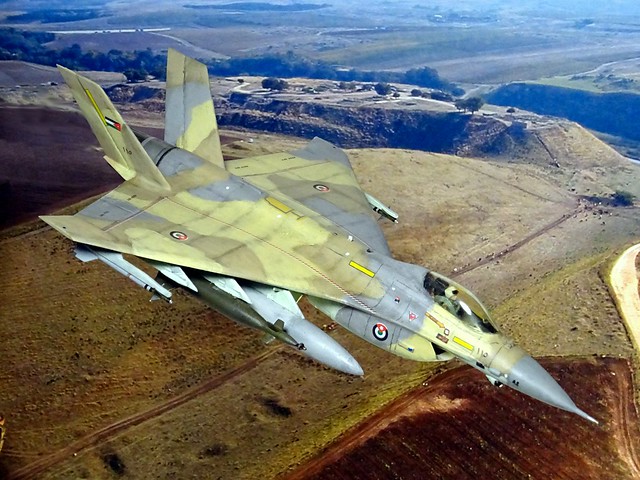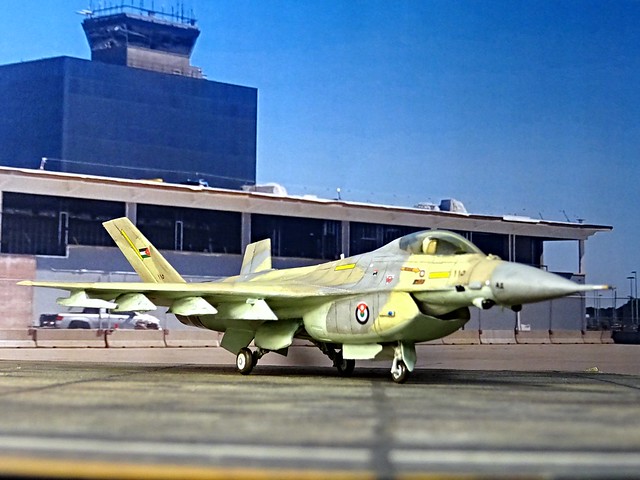
 Some background:The Lockheed Martin (originally developed by General Dynamics) F-16 Fighting Falcon is originally a single-engine multirole fighter aircraft, developed for the United States Air Force (USAF). Designed as an air superiority day fighter, it evolved into a successful all-weather multirole aircraft. Over 4,500 aircraft have been built since production was approved in 1976. Although no longer being purchased by the U.S. Air Force, improved versions are still being built for export customers.
Some background:The Lockheed Martin (originally developed by General Dynamics) F-16 Fighting Falcon is originally a single-engine multirole fighter aircraft, developed for the United States Air Force (USAF). Designed as an air superiority day fighter, it evolved into a successful all-weather multirole aircraft. Over 4,500 aircraft have been built since production was approved in 1976. Although no longer being purchased by the U.S. Air Force, improved versions are still being built for export customers.
One of these recent developments is the AF-16 “Strike Falcon”, a thorough update of the original fighter design as a 4.5 generation aircraft and optimized for the attack role. The prototype was presented to the public at the 2012 Singapore Air Show, and the type is intended for the export market as a simpler and less costly alternative to the F-35 multi role SVTOL aircraft.


Compared to the original F-16 fighter the new attack aircraft underwent considerable modifications – the most obvious is a new wing with more area (effectively, almost doubling it) and a much thicker profile, a V-tail layout and a fixed Divertless Supersonic Intake (DSI).
The AF-16’s new delta wing was designed around a large single piece of carbon fiber composite material. The wing has a span of 11 meters, with a 55-degree leading edge sweep and can hold up to 20,000 pounds of fuel – extending range and loitering time considerable. The purpose of the high sweep angle was to allow for a thick wing section to be used while still providing limited transonic aerodynamic drag, and to provide a good angle for wing-installed conformal antenna equipment.


Another side effect of the new wing’s shape is a highly reduced radar signature, which was further improved by the angular, canted twin tail fins and the DSI’s design that absorbs much of incoming frontal radar beams and totally blocks the moving parts of the jet engine.
A simple afterburner nozzle for the F110-GE-100 afterburning turbofan was retained, even though a 2D and even 3D vectoring thrust nozzle could be mounted.
The AF-16 features the same AN/APG-68 of the F-16C/D Block 25, but it has been optimized for the ground attack role, even though air combat capabilities are retained. This includes improved ground-mapping, Doppler beam-sharpening, ground moving target indication, sea target, and track while scan (TWS) for up to 10 targets.
The system provides all-weather autonomous detection and targeting for Global Positioning System (GPS)-aided precision weapons, SAR mapping and terrain-following radar (TF) modes, as well as interleaving of all modes. The system is also fully compatibility with Lockheed Martin Low-Altitude Navigation and Targeting Infra-Red for Night (LANTIRN) system, which was integrated into the forward fuselage (instead of pods on the F-16).


The AF-16 quickly attained interest, and one of the first countries to order the Strike Falcon is Jordan. Jordan gained independence in 1946, but its first air bases had been set up in 1931 by the Royal Air Force. By 1950, Jordan began to develop a small air arm, which came to be known as the Arab Legion Air Force (ALAF).
In July of 1994, King Hussein of Jordan signed a peace treaty with Israel, ending over 40 years of hostility between these two nations. Shortly thereafter, the government of Jordan began to lobby within the American government to purchase as many as 42 F-16A/B Fighting Falcons.
Following the 1994 Israel–Jordan peace treaty and the lending of Jordanian support to the United States during the Persian Gulf War, the U.S. recommenced full military relations with Jordan starting with the donation of 16 General Dynamics F-16 Fighting Falcon (12 F-16A and 4 F-16B) in storage at the Aerospace Maintenance and Regeneration Center (AMARC) at Davis Monthan AFB. Deliveries commenced in 1997 and were completed the following year, replacing the Mirage F1CJs in the air-defense role.


In recent years, U.S. military assistance has been primarily directed toward upgrading Jordan’s air force, as recent purchases include upgrades to U.S.-made F-16 fighters, air-to-air missiles, and radar systems.
Other types, especially the ageing F-5E/F fleet, needed replacement, too. The RJAF’s F-5E/F, as well as the remaining Mirage F.1s in the ground support role, took several years after the F-16’s arrival until the AF-16A could finally fill this gap in the RJAF’s arsenal. Fourteen machines had been ordered in 2012 (twelve AF-16A single seaters plus two AF-16B two seaters for conversion training) and were delivered in early 2015, allocated to No. 1 Squadron at Azraq. For twelve more an option had been agreed upon, while the RJAF F-16As will focus on the interceptor and air superiority role.
General characteristics: Crew: 1
Length (incl. pitot): 52 ft 1 1/2 in (15.91 m)
Wingspan: 36 ft (10.97 m)
Height: 12 ft 4 1/2 in (3,78 m)
Wing area: 590 ft² (54.8 m²)
Empty weight: 18,900 lb (8,570 kg)
Loaded weight: 26,500 lb (12,000 kg)
Max. takeoff weight: 42,300 lb (19,200 kg)
Powerplant: 1× F110-GE-100 turbofan with 17,155 lbf (76.3 kN) dry thrust and
28,600 lbf (127 kN) with afterburner
Performance: Maximum speed: Mach 1.2 (915 mph, 1,470 km/h) at sea level,
Mach 1.6 (1,200 mph, 1,931 km/h) at altitude
Range: 1,324 nmi; 1,521 mi (2,450 km) with internal fuel
Ferry range: 2,485 nmi (2,857 mi, 4,600 km) with drop tanks
Service ceiling: 42,000 ft (13,000 m)
Rate of climb: 50,000 ft/min (254 m/s)
Wing loading: 44.9 lb/sq ft (219 kg/m2)
Thrust/weight: 1.095
Armament: 1× 20 mm (0.787 in) M61A2 Vulcan 6-barrel Gatling cannon with 511 rounds
A total of nine hardpoints for Air-to-air missile launch rails and a wide range of guided and unguided
air-to-ground ordnance with a capacity of up to 17,000 lb (7.700 kg) of stores